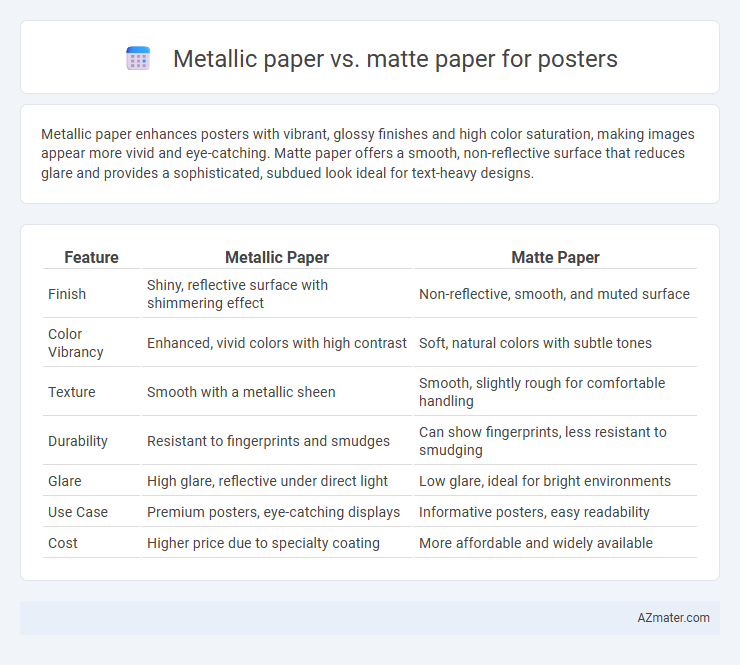Metallic paper enhances posters with vibrant, glossy finishes and high color saturation, making images appear more vivid and eye-catching. Matte paper offers a smooth, non-reflective surface that reduces glare and provides a sophisticated, subdued look ideal for text-heavy designs.
Table of Comparison
| Feature | Metallic Paper | Matte Paper |
|---|---|---|
| Finish | Shiny, reflective surface with shimmering effect | Non-reflective, smooth, and muted surface |
| Color Vibrancy | Enhanced, vivid colors with high contrast | Soft, natural colors with subtle tones |
| Texture | Smooth with a metallic sheen | Smooth, slightly rough for comfortable handling |
| Durability | Resistant to fingerprints and smudges | Can show fingerprints, less resistant to smudging |
| Glare | High glare, reflective under direct light | Low glare, ideal for bright environments |
| Use Case | Premium posters, eye-catching displays | Informative posters, easy readability |
| Cost | Higher price due to specialty coating | More affordable and widely available |
Introduction to Poster Printing Materials
Metallic paper for poster printing delivers vibrant colors and a glossy finish that enhances image sharpness and visual impact, making it ideal for eye-catching promotional materials. Matte paper offers a non-reflective surface with a smooth texture, reducing glare and providing a more subdued, professional look suitable for detailed text and subtle designs. Choosing between metallic and matte paper depends on the desired visual effect, durability requirements, and the environment where the poster will be displayed.
What is Metallic Paper?
Metallic paper is a specialized type of printing paper with a reflective, shiny surface that enhances color vibrancy and depth, making images appear more vivid and dynamic. It is coated with a pearlescent finish that gives posters a sleek, luminous effect, ideal for high-impact visuals and photography. Unlike matte paper, which has a flat, non-reflective texture, metallic paper creates a unique shimmer that attracts attention and adds a premium feel to printed posters.
What is Matte Paper?
Matte paper features a non-glossy, smooth surface that reduces glare and enhances readability, making it ideal for posters requiring clear text and subtle color tones. Its ability to minimize reflections ensures artwork and images maintain consistent visibility under various lighting conditions. Matte paper is favored for professional presentations and indoor displays where a sophisticated and understated look is desired.
Visual Impact: Metallic vs Matte
Metallic paper offers vibrant, reflective qualities that enhance colors and add a luminous, eye-catching sheen to posters, making images appear more vivid and dynamic. Matte paper, by contrast, provides a non-reflective surface that reduces glare, delivering softer tones and a more understated, sophisticated visual appeal. Choosing metallic paper emphasizes brightness and contrast for high-impact visuals, while matte paper prioritizes subtlety and readability in various lighting conditions.
Color Vibrancy and Print Quality
Metallic paper enhances color vibrancy with its reflective surface, producing brighter and more dynamic prints ideal for eye-catching posters. Matte paper offers a non-reflective finish that reduces glare, providing a smooth and elegant appearance but with less intense color saturation. Print quality on metallic paper excels in sharpness and contrast, while matte paper delivers finer detail with softer tones suitable for subtle designs.
Durability and Longevity
Metallic paper offers enhanced durability with a protective coating that resists moisture, scratches, and fading, making it ideal for long-lasting posters. Matte paper, while providing a glare-free finish, is more prone to wear and tear and may not withstand environmental factors as well. For posters requiring extended display life, metallic paper generally ensures superior longevity compared to matte options.
Best Uses for Metallic Paper Posters
Metallic paper posters offer a vibrant, glossy finish that enhances colors and contrast, making them ideal for promotional materials, event posters, and photo prints requiring high visual impact. The reflective quality of metallic paper amplifies light and details, perfect for marketing campaigns and art displays demanding eye-catching appeal. Compared to matte paper, which provides a non-reflective, subdued appearance suited for readability and subtle designs, metallic paper excels in environments where bold, dynamic visuals are essential.
Best Uses for Matte Paper Posters
Matte paper posters excel in environments that require minimal glare and enhanced readability, making them ideal for detailed artwork, photography, and text-heavy designs. Their smooth, non-reflective surface ensures vibrant colors appear consistently under various lighting conditions, perfect for indoor displays, galleries, or educational settings. Matte paper also resists fingerprints and smudges better than metallic paper, offering durability for frequent handling and long-term use.
Cost Comparison: Metallic vs Matte
Metallic paper for posters generally costs 20-40% more than matte paper due to its specialty coating and reflective finish. Matte paper offers a budget-friendly option with consistent print quality ideal for large quantity orders. Choosing between the two often depends on budget constraints and desired visual impact, with metallic paper suited for premium, eye-catching designs.
Choosing the Right Paper for Your Poster
Metallic paper offers vibrant colors and sharp contrast, making it ideal for posters that require eye-catching visuals and a glossy finish. Matte paper reduces glare and glare reflections, providing a more subdued, professional appearance perfect for text-heavy or artistic posters. Selecting the right paper depends on your poster's purpose, lighting conditions, and desired aesthetic impact.

Infographic: Metallic paper vs Matte paper for Poster
 azmater.com
azmater.com